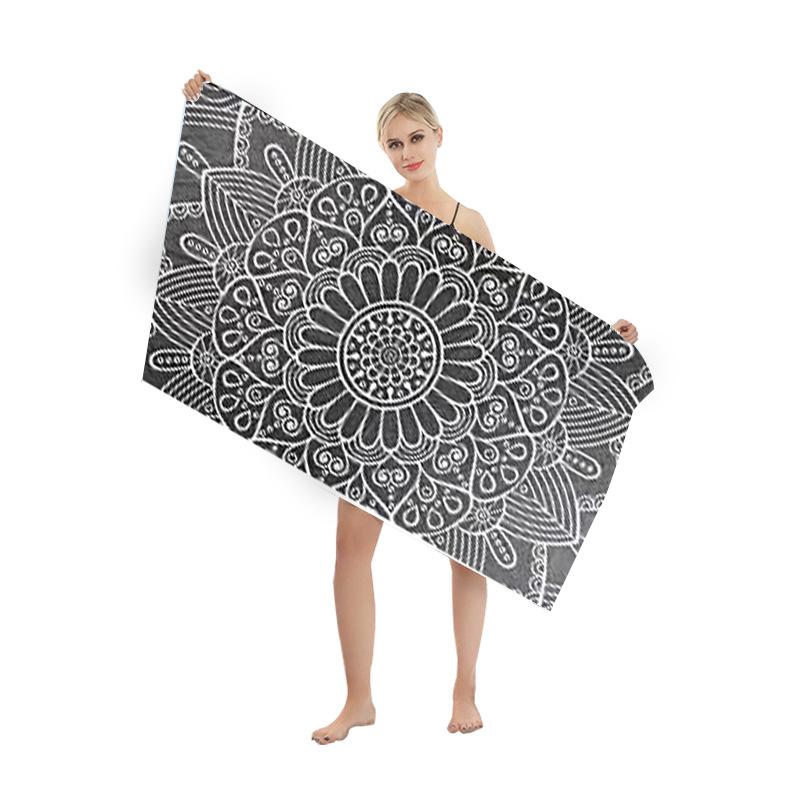For overseas wholesale purchasers of beach towels, accurately understanding material characteristics is key to product selection. The physical properties, cost structures, and market adaptability of different materials vary significantly. This article systematically analyzes the characteristics of mainstream materials and procurement strategies to facilitate efficient decision-making.Beach Towel Material Classification and Selection Guide:

I. Three Core Material Categories and Market Adaptability
(A) Natural Fibers: Premium Choices for Comfort and Sustainability
1. Cotton-Based Materials
- 100% Cotton
✅ Core Advantages: Excellent skin-friendly natural fibers with a water absorption rate of 500ml/min (30% better than synthetic fibers). Organic cotton certified by OEKO-TEX meets European environmental standards.
⚠️ Limitations: Requires 4-6 hours to dry completely at room temperature, with a shrinkage rate of 5%-8% after 30 machine washes. Pre-shrunk products are recommended.
🌍 Market Positioning: Suitable for Nordic and German markets emphasizing naturalism, targeting family users and high-end resorts.
- Cotton Blend (e.g., 80% Cotton + 20% Polyester)
✨ Improved Features: 20% faster water absorption, drying time reduced to 2-3 hours, and 40% higher tear resistance than pure cotton.
📍 Typical Application: Hot-selling in the U.S. camping market, balancing warmth for campfire use and quick-drying for beach scenarios.
2. Linen
🌱 Material Highlights: Natural pectin provides antibacterial properties (bacterial inhibition rate >90%), with thermal conductivity 35% better than cotton, reducing skin temperature by 2-3℃.
💡 Procurement Tips: French and Italian markets prefer 200-300gsm medium-thick styles. Highlight the “softer with each wash” experience and include linen care guides to boost repurchases.
(B) Synthetic Fibers: Prioritizing Cost-Effectiveness and Functionality
1. Polyester
🚀 Industrial Advantages: Polyester beach towels using DTY low-elastic yarn technology have a wear resistance exceeding 100,000 cycles, color fastness up to ISO 105-B02 standard level 4, and support high-precision digital heat transfer printing.
🌴 Regional Adaptation: Preferred in Southeast Asian markets (e.g., Phuket, Thailand), where daily humidity >85% makes polyester dry 3x faster than cotton at 20%-30% lower cost than cotton blends.
2. Nylon (Polyamide)
⚙️ Performance Data: Tensile strength of 5.0-5.5g/dtex (polyester: 4.0-4.5g/dtex), elongation recovery rate >90%. Ideal for 2-in-1 beach towel + storage bag designs to meet lightweight needs for outdoor sports.
🏄 Case Study: Best-selling in the Australian surfing market, nylon with sand-resistant coating removes 90% of fine sand with a shake, becoming essential gear for surfers.
3. Acrylic
❄️ Differentiated Advantage: Dumbbell-shaped fiber cross-section provides 25% better heat retention than cotton, suitable for morning swimming in temperate regions (e.g., UK coastal cities). Coral fleece processing enhances softness.
(C) Blended Materials: Balancing Diverse Needs
🔬 Innovative Combinations:
- Bamboo Fiber + Polyester (30%+70%): Bamboo fiber’s natural antibacterial properties (99% E. coli inhibition) combined with polyester’s quick-drying make this a top choice for Japanese hot spring hotel custom orders.
- Recycled Polyester + Cotton (50%+50%): Recycled polyester from PET bottles reduces carbon footprint by 40% compared to virgin polyester, compliant with EU EPR regulations, ideal for B2B procurement.
II.In depth analysis of procurement decision-making dimensions
1.Performance Priority Matrix
📊 Scenario-Performance Matching Table:
| Usage Scenario | Core Indicators (Weight) | Recommended Materials |
| Home Pool | Water Absorption (40%) + Softness (30%) | Pure Cotton/Cotton Blend |
| Island Tourism | Quick-Drying (50%) + Lightweight (30%) | Polyester/Nylon |
| Gift Customization | Touch (30%) + Environmental Attributes (30%) | Linen/Bamboo Blend |
2.Sustainability Enhancements
🌱 Certification Systems:
- Organic Cotton: GOTS Global Organic Textile Standard (3-year soil conversion period required)
- Recycled Fibers: GRS Global Recycle Standard (minimum 20% recycled content)
- Water-Saving Processes: Bluesign® Certification (50% less water consumption than traditional methods)
3.Supply Chain Risk Control
⚠️ Supplier Evaluation Checklist:
1.Provide material testing reports (ASTM D3776 grammage test, AATCC 15 perspiration fastness test)
2.Support small trial orders (500 units minimum)
3.Offer free sampling (3-5 day sample lead time)
III. Three-Step Practical Procurement Method
1. Gold Standard for Sample Testing
🔬 Laboratory-Level Tests:
- Water Absorption: 50ml water drop diffusion time <10 seconds (excellent)
- Quick-Drying: 100g moisture content towel dries completely <2 hours at 25℃
- Color Fastness: No obvious fading after 50 dry rubs; resistant to 24-hour seawater immersion
2. Trend Tracking Toolkit
🔍 Market Intelligence Sources:
- Google Trends: “quick dry beach towel” search volume up 25% annually in Southeast Asia
- Amazon Bestsellers: Antibacterial-labeled beach towels show 18% higher repurchase rate
- Industry Exhibitions: Focus on “biodegradable beach towel” concepts at ISPO Munich
3. Deep Supplier Collaboration Strategies
🤝 Value-Added Services:
- Joint R&D: Co-develop “climate-adaptive” product lines (e.g., UV-resistant materials for the Middle East)
- Inventory Sharing: Adopt VMI (Vendor-Managed Inventory) to reduce 30% overstock risk
- Certification Sharing: Split GOTS certification costs (~$5,000/time) to lower entry barriers for small/medium purchasers

